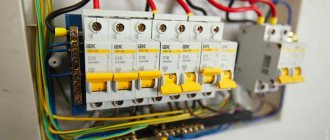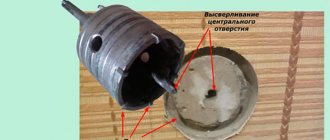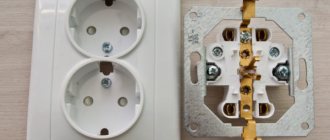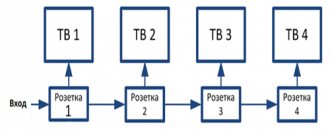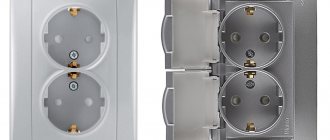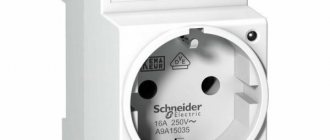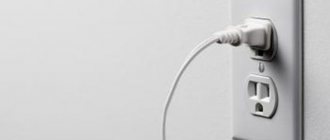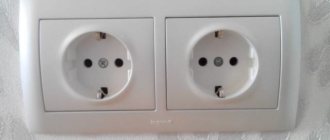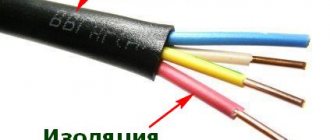Wall-mounted sockets are more popular than overhead sockets. Their undeniable advantage is their compactness and the absence of surfaces for collecting dust. They are reliable in terms of resistance to mechanical stress. Their most important advantage is the hidden wiring, which eliminates the creation of obstacles when finishing the interior. To get all these benefits, you must first figure out how to install a socket in the wall . You can do this yourself, even if you have to install a socket box and lay wires. Connecting sockets is much easier than installing light switches.
Connecting the socket in the installation box
Briefly about the types of built-in sockets
The technical parameters of the outlet must fully comply with the requirements of the connected consumer. You need to look at the power of the devices that will be powered by it. The maximum permissible current in Amperes is indicated on the housing of the sockets and in their instructions. The power of the connected electrical equipment is measured in kW. These values can be compared using the table.
Table 1. Correlation of socket power to consumer parameters and required wiring cross-section.
| Outlet current A | Consumer power kW | Wire cross-section mm2 | |
| Aluminum | Copper | ||
| 6 | 1.3 | 2.5 | 1 |
| 10 | 2.2 | 2.5 | 1.5 |
| 16 | 3.5 | 2.5 | 1.5 |
| 32 | 7 | 10 | 6 |
All built-in sockets that may be needed for installation in an apartment or private house can be divided into 3 groups:
- ordinary;
- waterproof;
- power.
Conventional sockets are used to power the vast majority of electrical appliances. You can connect a mobile phone charger, computer, router, hair dryer, refrigerator, microwave oven, etc. to them.
Regular socket
Waterproof sockets are used for installation in wet areas, usually in bathrooms. They can be distinguished from ordinary ones by the presence of a lid covering the socket for connecting the plug. It provides splash protection. Such an outlet will be required if the installation is carried out in close proximity to a sink, shower or bathtub. For this purpose, devices with protection class IP44 and higher . This will reduce the likelihood of electric shock even in the event of flooding, which is accompanied by water leaks along the walls. If the installation is carried out in a large bathroom of a private house far from water sources, then you can get by with a regular outlet.
Waterproof socket in the bathroom
Prices for waterproof sockets
Waterproof socket
Power sockets used in houses and apartments usually have the same plug standard, but have a higher power rating. Their indicator for this parameter is 32A and above . They are used to connect devices with high electricity consumption. First of all, this is an electric stove, electric oven, air conditioner, fireplace or boiler. Sometimes power outlets may have a triple socket. Their choice depends solely on the plug with which the electrical appliance is equipped.
Power socket
Prices for power sockets
Power socket
Classification of sockets by installation type
Household quick-disconnect electrical connectors (sockets), in accordance with the specified classification, are usually divided into two types:
Overlays are installed directly on the wall surface. Because of this installation method, they are also called external.
Installation can be done on almost any type of surface (brick, concrete, wood, etc.). Built-in. This term indicates that installation will be carried out in sockets, usually made in the walls.
If, as a rule, questions do not arise with the first type, then with the second, there are nuances. As mentioned above, installation is carried out in planting nests, the subspecies of which differ significantly from each other.
We will not give the design of these devices, since a detailed description can be found in other publications on our website.
Precautionary measures
Since there is a possibility of electric shock when performing work, it is necessary to turn off the power to the apartment or house during electrical installation. This can be done using switches in the electrical panel. If the room has old-type wiring, you can turn off the power supply by unscrewing the plugs on the meter. Work on installing a socket box, when contact with live wires is excluded, is carried out without turning off the power, to allow the use of auxiliary power tools.
Attention! Before proceeding directly with electrical installation, you should make sure that the wires are actually de-energized. The check is carried out with an indicator screwdriver or tester.
Checking for voltage
Prices for voltage measuring instruments
Voltmeter
Socket device
Modern sockets are distinguished by a recessed seat and wider holes for the pins of the electrical appliance plug.
Thanks to the deep fit, the fork is securely and firmly fixed in the holes.
Working elements:
- The base of the socket is made of ceramic or plastic. Substances that prevent fire are additionally added to the plastic. On the sides of the base there are ears or holes with screws for installation in a socket box.
- Current-carrying parts are fixed to the base, which are made of brass, tinned brass or bronze. Brass contacts are installed on cheap budget products. They oxidize quickly. Also, during operation, they unclench, the strength of the connection is lost, the contact heats up and begins to burn. Tinned contacts do not oxidize, so they are installed in places with high humidity, such as bathrooms and kitchens. Bronze does not oxidize and provides a strong, reliable connection of contacts.
- The front part is a plastic panel that covers the operating mechanism and fastening screws.
- Contacts with a grounding wire are installed to connect powerful household appliances and electrical equipment that require constant voltage parameters and create an electrostatic field.
- The wires are attached to the socket using terminals. In a screw terminal, the wire between two contact plates is secured with a screw. In a screwless terminal, the wire is fixed with a special clamp with a spring. Simply insert the wire into the hole and it will press automatically.
Socket height standards
Initially, you need to decide where exactly and at what height the outlet will be installed. There are so-called European and Soviet standards. According to the first, installation is carried out at a height of 30 cm from the floor. The Soviet standard provides for a level of 90 cm .
Eurostandard
You don't always need to be tied to the requirements, as there are cases where this option is not suitable. First of all, the need to install a socket at a different height arises in the bedroom, in particular when installed above a bedside table. It is placed in such a way that you can reach it while lying down, for example, to charge a mobile phone. It is convenient for the socket to be at a height of 65-70 cm .
Installation option above the bedside table
The location of outlets in the kitchen deserves special attention. Downward installation is excluded since they will be covered by furniture. They are mounted in any order, usually trying to be placed immediately above the countertop or under the bottom of the upper cabinets. In the latter case, they are invisible at a glance, but are always accessible.
Placement above the kitchen countertop
Installation of overhead sockets
This is the easiest installation option; if you follow the instructions below, you will not have any problems with the installation. We will assume that the locations of electrical points have already been marked; in this case, the algorithm of actions will be as follows:
We disassemble the structure into its component elements (unscrew the top panel, remove the mechanism from the bottom panel).
An example of a disassembled outdoor socket. We cut out the plug through which the wires will be fed (marked with a green circle in the figure above). We screw the bottom panel to the wall (if it is made of flammable material, we place a metal plate prepared in advance).
If the wall is concrete or brick, you must first drill holes for dowels at the fastening points. The mounting holes on the housing are marked in Figure 7 with red circles. Before tightening the fasteners, the base should be level. We install the mechanism on the base. We make the connection (this process will be discussed in detail in a separate section, since it is performed the same for all types of devices). Screw on the outer panel.
As you can see, there is nothing complicated in this process. Now let's move on to the embedded installation.
Selecting a Receptacle-Compatible Mounting Box
Built-in sockets are fixed in a special installation box, the so-called socket box. It is a thin-walled cylinder that is walled into the wall. In the future, the socket is attached to it, and not to loose masonry material or concrete, which would be unreliable.
Advice! It is better to buy the installation box at the same time as the socket, which will ensure their full compatibility.
Sockets from individual manufacturers provide different methods of attachment to the socket box. First of all, this concerns the location of the screws. They can be located along a vertical or horizontal axis. Some devices have 4 mounts at once. The diameter of the installation boxes is 65-67 mm . Depth 45 mm . They can be made of polyamide, polypropylene and other materials.
Regular socket box
Attention should be paid to the selection of the installation box for the socket block. The fact is that almost every manufacturer produces its products to different width standards. That is, the distance between the sockets, including the overhead panels, differs so much that it will not always be possible to install it in an installation box of another brand.
Attention! If fastening is required in ordinary walls, classic cylindrical socket boxes are used. For installation in plasterboard, special installation boxes are produced with special screws and ears for attaching to the sheet.
Socket box for drywall
Classification, features and sizes of socket boxes
Depending on the material of the surface where the installation will be carried out, mounting sockets are divided into two types:
- Under drywall.
- For concrete and brick.
The differences between these types are that the first are fixed using special ears (marked with red circles in Figure 3), and the second are “frozen” into the wall with gypsum mortar.
In addition, “glasses” can be single or composite. The first (they are shown in Figure 3) are used for single structures, the second - for a group of sockets.
Composite socket boxes for plasterboard (A) and concrete or brick (B)
If you plan to install two electrical points, then it makes sense not to drill a second hole for the socket box, but to choose a double socket design. This is especially true when installation is carried out on a concrete surface.
Double socket design for installation in one socket box
As for the material, plastic is used for concrete, brick and plasterboard surfaces; if hidden installation is carried out in a combustible base, then it is necessary to use metal socket boxes.
Concluding the topic of landing sockets, we present their standard sizes; this information will be useful both at the design stage and during installation work.
Typical sizes of socket boxes
Having finished with the theory, let's move on directly to the installation process. Let's start from simple to complex.
Installation of a socket box
After purchasing materials, you can outline the installation location. The technology used for installation differs depending on the type of wall. Working with concrete, aerated concrete and brick is almost identical, but working with drywall is different. Differences are also observed in the set of tools that are required.
Installing a socket box in concrete, aerated concrete or brick
Working with such wall materials requires specialized tools. You will need to prepare:
- perforator;
- core drill 68 mm;
- chisel or pick for a hammer drill.
Core drill
Prices for socket drills (core drill)
Core drill
First you need to make a mounting hole in the wall to install the socket box using a special core drill. It is installed on a drill or hammer drill. Crowns come in different price segments and differ in cutting edge material. They come in diamond and carbide. Drills also differ in operating mode. Some are used only with a drill, while others are impact, so they are suitable for drilling with chiselling included.
Recommendation! When purchasing a core drill, you need to consider not only its diameter, but also the type of shank. For doors it should be cylindrical, and for a hammer drill sds-plus or another. Otherwise, the incompatible crown will not fit the existing instrument.
If you need to drill reinforced concrete, you will need to use a more expensive diamond-coated bit on the segments, since cheap equipment breaks. You also need to set the optimal number of revolutions recommended in the instructions for the drill.
There is a concrete drill in the center of the cylindrical crown. It is used for alignment. The protruding drill is placed in the center of the future socket box and deepened into the wall until the ring begins to be drilled with a crown. After this, you need to stop drilling and remove the alignment. This will prevent the protruding part of the tool from making a through hole. The centering drill is removed by knocking it out with a wedge or unscrewing a special clamping bolt.
Drilling into the wall
If you need to install a block of sockets, then you need to look at their instructions, as well as the parameters of the socket boxes and determine the center distance. Usually it is 71 mm . To make everything smooth, ideally, immediately after removing the crown to remove the centering drill, you need to make markings from the small hole along a horizontal line in increments of 71 mm . The resulting points will be used in the future to center subsequent drillings.
Marking for a block
After drilling, a circular hole will remain. All that remains is to knock out its central part. This can be done conveniently using a hammer drill with a lance. You can get by with an ordinary hand chisel and hammer. You need to insert the tool into a narrow strip of a larger drilled circle and strike. As a result, the central part will fall out. When working with aerated concrete or brick, this is not difficult. It will be more difficult to knock out concrete if it is reinforced with steel reinforcement.
Installation sequence
Having a hole ready, you can cut a groove in the wall to the ceiling, where the junction box is located, in order to make a branch of the power cable. To compensate for the error, the laid cable is taken 30-40 cm . In the future, the excess can be cut off. When moving on to laying the cable and connecting to the junction box, you will need to turn off the power to the room.
Junction box
After preparing the groove and the hole itself for the socket box, you need to insert the installation box into it and check the depth so that nothing sticks out. Next, you should prepare a thick mortar. It is most convenient to use alabaster and gypsum plaster.
To insert the power wire into the box, you need to break out the window using pliers or cut it off with a knife. In such places, manufacturers make the plastic thinner to allow mechanical extrusion. Next, you need to place a little solution deep into the hole, and then insert the box with the wire inserted into it.
Gluing socket boxes
The socket box should be leveled using a level. If it has only two vertical or horizontal fasteners, then their orientation must be selected depending on the characteristics of the purchased outlet. If there are 4 fasteners, this does not matter.
Socket box with two fastenings
The side cavity between the box and the wall is also filled with solution. If alabaster was used, then after 3-4 hours the installation box will sit securely. You should wait until the solution is completely dry and stops evaporating. Under no circumstances should foam be used to secure the socket boxes, as it is a flammable material.
Advice! If you need to install one or more sockets, then it is not advisable to buy an expensive crown. Holes can be cut with a grinder. In this case, the amount of dust from the work increases. Although accuracy suffers, everything will then be covered with plaster. To cut with a grinder you will need a diamond wheel.
Work as an angle grinder
Prices for popular models of wall chasers
Wall chaser
Video - Installation of socket boxes in a concrete/brick/aerated concrete wall
Preparatory work
Planning is an important matter before the actual installation of electrical wiring and installation of sockets. It is necessary to take this seriously so that in the future a number of difficulties do not arise in the operation of electrical appliances, when something is not enough in one place, and in another it experiences increased load.
At the planning and preparatory stage you need to:
- Determine the location of sockets and connected devices;
- Draw a wiring diagram;
- Separately, for each room, calculate the required number of wires, sockets, switches involved in the installation process;
- Prepare the necessary tools, self-tapping screws, screws, screws, dowels;
- Hollow out a niche for the socket box and grooves for laying the cable.
It is important to calculate and plan everything correctly from the very beginning, so that you don’t have to redo anything later or correct gross mistakes that lead to damage to the material and additional gating of the walls.
During the work you will need the following equipment:
- A hammer drill with a diamond crown for preparing a niche for a socket box;
- Screwdrivers with different blade configurations (flat and Phillips);
- Pliers with wire cutters;
- Wire with a cross section of 2.5 mm;
- Sharp knife for stripping wires;
- Socket box;
- Plaster mixture, gypsum or cement mortar;
- Socket of the required model and configuration.
Methods for installing sockets are available for viewing in numerous photos and drawings. They are simple and will not cause any difficulties even for a novice electrician:
- Installation directly into the wall in a pre-installed socket box;
- Overlay on a protected surface without digging into a niche (dielectric fire-resistant plates are used to secure the socket core to them).
A recess is first made for the socket box, in which it is placed with the wires installed on a cement or gypsum mortar.
We use a hammer drill with the necessary attachments and protect the respiratory system from dust.
After the construction mixture has dried and the glass of the socket box is held securely, we proceed to the direct connection and installation of the socket.
Installation of socket boxes in drywall
To work with drywall, you will need a special type of mounting box with a special claw, which will allow you to press it to the sheet like a vice or clamp. To carry out installation, you need to drill a hole. This can be done with a special core drill for drywall. You can cut a circle with a mounting knife. Since the wires are hidden behind the drywall, no gating is required. The embedded cable should be pulled out into the resulting hole and inserted into the broken window of the socket box. You need to insert the mounting box into the wall and tighten the screws, retracting the clamping tab.
Fastening the socket box in plasterboard
Features of installation in a panel house
Panel houses have nuances:
- for electrical wiring installed using the open method, there is no need to drill a place for the box;
- in the case of closed electrical wiring, grooves for conductors will be required, while the cable is laid in a corrugation.
It is necessary to use corrugation. It protects the conductor from breaking, which can lead to short circuits and inoperability of sockets and switches.
The box can be fixed using gypsum mortar. When it dries, the process of connecting the electrical fittings continues. Electrical sockets are a must-have attribute in the home. Based on the type of installation, they are divided into overhead and internal. The choice depends on the type of wiring. The connection method is the same and does not cause any difficulties. Even an ordinary person can connect the outlet. It is only important to follow the installation instructions and safety requirements when working with wires.
Connecting the socket
Direct connection of the socket when installing in drywall is carried out immediately. If the mounting box is secured with mortar, you will have to wait 2-3 days . The sequence of further actions is as follows:
- shortening the protruding cable;
- stripping the ends of conductive wires;
- screwing the wires to the socket terminals;
- installation of an outlet;
- fixing the decorative frame.
The tail of the wire protruding from the socket is too long, so it will need to be trimmed. It is necessary to leave such a length that when folded it can be hidden in the remaining space of the box. The ends of the wires are cleared of insulation. In the absence of a special tool, this can be done with a mounting knife, being careful not to damage the conductor. The instructions for the socket recommend stripping the clay to 10-15 mm .
Wire stripping degree
To properly connect the wires to the socket terminals, you need to separate the grounding conductor, if any. Phase and neutral have single-color insulation, and grounding has two-color insulation. The supply wires are connected to the side terminals. Grounding goes in the center.
Electrical installation
The next step is to carefully fold the wires to place the socket in the installation box. Next, using a screwdriver, you need to screw it to the socket box using screws. Fixing with spacer pads is also possible. They are located on the sides of the socket. The more you twist them, the wider they move apart and provide rigidity of fixation.
Attaching to a socket box
After securing the socket, you need to snap its frame. If it is not there, then screw on the cover panel. It is held in place by one screw, centered between the plug holes.
Video - DIY socket installation
Subtleties of connecting the socket block
When connecting a double, triple or block of sockets, a parallel connection will be required. To do this, small pieces of wires measuring 15 cm . Their ends are stripped of insulation. Such segments are used to connect socket terminals. On sale you can find special blocks immediately connected to each other.
Block connection
Installing a grounded outlet
A grounded socket is installed in the same way as simple sockets, the only exception is that a grounding conductor is supplied and connected to this type of electrical device.
Accordingly, to install a simple 220V outlet, we only need a two-core cable (as in the examples above), but for a grounded outlet we need a three-wire cable.
Grounded sockets can also be internal or external and have a different number of sockets.
Sockets with grounding are necessary when connecting any powerful equipment, as well as equipment with electronic monitoring and control systems: electric ovens, hobs, modern refrigerators, desktop computers, LED TVs. Grounding is also required for equipment whose operating cycle is directly related to water: washing machines and dishwashers, water heating boilers, etc. The plugs of such devices have a special grounding contact:
Below is an example of connecting a double socket with grounding “Etude” from the manufacturer Schneider Electric:
Step 1.
Removing the decorative panel:
The photo below shows the attachment points of the power cable cores and the bolts for fixing them:
Step 2.
Using an indicator screwdriver, make sure there is no voltage on the cable:
Step 3.
We connect the cable to the outlet and carefully fix its wires:
Step 4.
We install the socket in the socket box and fix it:
Step 5.
Reinstalling the decorative panel of the socket:
What to do with aluminum wiring
In older houses, all wiring is made of aluminum. Often such wires break off, so when you try to insert a new socket into an existing socket in the wall, you cannot connect. In this case, you will need to extend the wire. The use of ordinary twisting is unacceptable. To get out of the situation, you can use special glued pads. This will make it possible to build with copper wires, which eliminates oxidation between two different metals. By adding a couple of wires of 10-15 cm , you can connect an outlet.
Wire extension
Installation of power sockets for powerful consumers
If there is a need to power a powerful electric stove, oven or other equipment, then you need not only to choose a power outlet, but also a large cross-section cable. Its throughput must correspond to the consumption parameter of the electrical appliance. The wire for such equipment should not have twists in its path. It is not connected to the junction boxes, but is led directly to the electrical panel. This is a mandatory fire safety rule.
Types of sockets
To install a single-phase electricity line with a voltage of 220, the following types of structures are used:
- With side grounding contact (C 2a). Their design assumes the presence of an additional terminal to which the green wire is connected. More often, this type of socket is installed for powerful household appliances (electric stove, boiler).
- Without grounding (C 1a). Regular sockets designed for a maximum operating current of 10 A. They can withstand voltages up to 250 V and do not require grounding.
- Devices with a pin grounding terminal. It is mounted depending on the type of plug being connected. Such elements have standard C 3a.
Socket with a grounding pin Socket without a grounding contact Socket with a grounding contact
Additionally, sockets are classified into types according to the type of design:
- External (overhead). Designed for self-installation on the walls of wooden log houses and panels. If the master does not know how to install an outlet in such buildings, he should follow the fire safety rules. Embedding power points into wood is strictly prohibited.
- Built-in (internal). Used for installation in walls made of monolith, brick, foam concrete, plasterboard.
Overhead socket Built-in socket Additionally, sockets are divided into types according to the method of fastening the wires in them:
- With spring terminals. The stripped wires are inserted into a special technical hole and are fixed automatically.
- With a screw. The wires are pressed to the terminals by tightening small fasteners.
There are also floor-mounted mini-columns, with the help of which you can output from 2 to 6 power supply points simultaneously. They can be added if you need to connect a large number of equipment in one place.
Before making a socket, it is important to consider that the installation of a power point without grounding can be carried out using a two-core double cable (with two wires inside). The grounding element is installed using three-core (triple) cables. The yellow wire is intended for connecting the required terminals to the apartment ground.
How to add an outlet in an apartment
A cheaper and faster option would be to add one or more outlets in the apartment without completely replacing the wiring. This option is relevant if renovations in the apartment are not planned in the near future, and also if the electrical wiring in the apartment is in good condition, or has recently been replaced. Of course, it is advisable to think about the number of electrical outlets and their locations in the apartment before starting renovations. However, if the moment has already been missed, you need to decide how to connect an additional outlet in the apartment
How to place a cable and socket on the wall
When installing additional sockets in an apartment, first of all you need to decide what type of socket will be used - external or internal installation, that is, surface-mounted or built-in. The same applies to the cable from the outlet to the electrical wiring section that already has power. Because there is a hidden or open way to install the cable.
Hidden wiring and built-in socket
It’s up to you to decide which option for installing the socket and laying the cable. A built-in socket and hidden wiring naturally looks like the most successful option from an aesthetic point of view. However, as mentioned above, in most cases this option entails quite expensive repairs. It will be necessary to groove the wall and make a hole for the mounting box. In this case, the integrity of the wall will be compromised and its finishing coating will be damaged.
Exposed wiring and overhead sockets
Installing the cable in an open way (outside the wall), as well as installing surface-mounted sockets, will allow you to complete the work with the least labor costs, as well as minimize the amount of dust and dirt. This method will allow you to preserve the finishing coating of the wall on which you plan to install the outlet and lay the cable.
Open wiring installation: minimum costs and work
The disadvantage of this method is that the added section of wiring will be visible, which does not look very neat. There are several ways to solve this problem. For example, if possible, lay a section of wiring, hiding it behind the interior elements of the room. This will no longer be noticeable, and may be an acceptable option. Also, a fairly simple solution is to place the cable under the baseboard - this does not entail large-scale repair work, and in itself is a fairly economical option.
How to add an outlet in an apartment with plasterboard walls
In the case where the walls in the apartment are finished with plasterboard, the installation of hidden electrical wiring elements is greatly simplified. To install a socket in this case, you will need to select an empty opening between the profiles mounted on the wall and make a hole for the mounting box. If the socket is located under the distribution box, then an additional section of cable can be laid in the void between the profiles. Or stretch the wire down, and lay the wire below in the cable channel or inside the plinth, which is structurally designed for laying the cable.
You can lay the wiring unnoticed by running it inside the baseboard
There are many options for installing wiring - it all depends on the specific conditions in the apartment. The final choice, as always, is yours.
Step-by-step installation instructions
You must begin installation work from your own safety. Make sure there is no power to your home or apartment. If this is not done, it can be turned off in a common circuit breaker for the whole house. It is also worth considering protecting your hands and fingers with gloves. Of course, working in them while installing the outlet itself is quite inconvenient. But at the time of laying the cable and cutting out the hole for the “socket box”, this is a necessity. After all, you can get injured in the process.
Safety regulations
Installing an outlet, like any type of electrical installation work, requires strict adherence to safety regulations:
- Before starting work, you must turn off the power by turning off the machine/unscrewing the plug in the electrical panel and make sure that there is no voltage using the indicator.
- Take measures to prevent the supply of electricity: warn household members, install a warning sign on the landing.
- Check the serviceability of the tools used, paying special attention to the integrity of the insulation.
Having familiarized yourself with the main stages and subtleties of installing a socket, you can do this work, which previously seemed incredibly difficult, with your own hands. After all, everything happens for the first time, and the most experienced electricians once also took their first steps in mastering these skills.
Briefly about retractable sockets
In the article we did not pay attention to this type of electric point. This concept has only recently been introduced to the market, but is nevertheless quickly gaining popularity.
Structurally, such devices are much more complex than standard products, and accordingly their cost is much higher. The factor of novelty also has an important influence on the price.
In the near future, an overview of these devices will be presented on our website, including information on how to install a socket of this type.
DIY socket replacement
It is not uncommon for an electrical outlet in an apartment to fail. This usually happens with those that are most frequently used. Naturally, problems arise in the house with turning on the TV, washing machine or other household appliances.
And the owners are faced with an urgent task - how to replace the outlet, and urgently. It can be resolved in various ways.
And in most cases, the last option is the most efficient and preferable.
Socket block sizes
When socket boxes are installed 2-3 in a row at once, then this is done by installing a set of socket boxes.
- To drill holes for suitable sizes of socket block, take a crown with a diameter of 68 mm to 80 mm.
- The landing niches are made interconnected, and the gap between the axes is 71 mm.
- A transverse mark is placed regarding the wire that needs to be inserted on the right, then a mark is placed on the wall for drilling the landing niches, taking into account the required axial distance, or it is traced along the contours of the block with a pencil.
- Holes are made, then using a chisel and a hammer, they scrape out what is unnecessary, remove the partitions, and drag the wire along the placement line.
- The margin in diameter will facilitate the even alignment of the block. Here the transition ears play the necessary role - they connect the socket boxes into a common block.
Making holes
There are three ways to create holes in a wall:
- Using a concrete crown.
- Using an impact drill, hammer drill and pobedit drill.
- Using a grinder (angle grinder).
First option (crown for concrete)
This method can be considered the most frequently used. To make holes, a special device is used - a concrete crown, put on a hammer drill.
The cutting element of the crown is a diamond-coated part. You can use pobedite nozzles. Heavy-duty material makes it easy to destroy any hard surface. The cut is smooth and round. In the inner part of the nozzle there is a concrete drill, designed for centering the cutting element.
Note! The nozzle must have a larger diameter than the dimensions of the installed socket box.
We place the drill at a given point and begin to immerse the crown into the material. When the cut is completed, we hollow out the remaining concrete. To do this we use a hammer and chisel.
Second option (drill, hammer drill, pobedit drill)
If you don’t have a concrete bit, you can make a hole for the socket using a Pobedit drill bit. It is best to make a hole with a hammer drill, and if a tool is not available, an impact drill will do. In the latter case, the process will be more labor-intensive.
The circle is drilled along a pre-drawn line. The step is taken as small as possible. To control the depth of penetration, it is recommended to use electrical tape tied to the drill. As in the first option, we finish the work using a hammer and chisel.
Third option (Bulgarian)
A grinder is not the best way to make round holes, but is more suitable for creating squares. However, if you don’t have any other tool, you can make a hole for a socket in the wall using a grinder.
We select a special disc for concrete. Draw a square instead of a circle. We make 4 cuts in the wall along the drawn lines. The depth of the cuts slightly exceeds the size of the socket box. We remove the remaining concrete with a hammer and chisel.
Adjusting the hole to the size of the socket box
When the hole is made, we check how well the socket box fits under it. Since the hole was initially made larger than the diameter of the socket box, problems with the width should not arise. The main effort is usually put into adjusting the desired depth.
We bring the hole to a depth at which the socket box will be buried in the niche by about 5 millimeters. The depth reserve is provided taking into account the placement of fixing material (gypsum or alabaster mortar) into the hole. In addition, a certain place will be occupied by the bend of the wire suitable for the device.
Advice! To make further work easier, it is recommended to trim the edge from the edges of the hole. We do this using a knife.
By adjusting the depth, the installed socket box will be hidden in the hole along with the outer skirt. This will allow you to install the device in the same plane with the wall. If the skirt is not recessed, you will end up with a gap of 1 - 2 millimeters between the rosette frame and the wall.
Cable selection
To avoid overheating of the wiring and its subsequent failure, it is necessary to observe certain requirements when choosing a cable. For installation in an apartment, a two-core or three-core wire is used. A two-core wire consists of two wires - zero and phase; grounding is not used in this case. The three-core wire allows for grounding. Grounding increases the safety of using electrical wiring and also reduces the risk of electric shock. You can use grounding when adding an outlet in an apartment only if there is a grounding conductor in the area from which you plan to connect a new section of cable.
A two-core wire consists of two cores - zero and phase
Cable material and diameter
Also, when choosing a cable, it is necessary to take into account the diameter of its cross-section and the material from which it is made. In apartments and residential buildings, according to fire safety requirements, it is advisable to use copper cable. Compared to aluminum, copper overheats less and can withstand greater loads. The diameter of the cable used in apartments can be from 1.5 to 3 square millimeters, however, according to the table of long-term permissible current loads for electrical household appliances with a total power of 2 to 4 kW, it is advisable to use a cable with a cross-section of 2.5 square millimeters.
Connecting from an existing outlet
Let's look at one of the easiest ways to add an outlet in an apartment - connect to an existing outlet. This method involves connecting a cable to a new additional outlet from another outlet already in the room. This method can be used when connecting a new outlet only if you do not plan to use high-power electrical appliances. As a rule, in this case a cable with a cross-section of 1.5-2 square meters is supplied. mm, suitable for the use of household electrical appliances with a power not exceeding 2 kW. The use of more powerful electrical appliances can lead to overheating of the contacts, cable failure and poor connection quality.
Total load calculation
In this case, the load must be calculated in such a way that, together with the load of the existing outlet, the total load does not exceed the permissible for the cable and other elements of the electrical wiring laid to this outlet. That is, using this method, you can connect one outlet from another if the total load of both outlets does not exceed the maximum for a given section of the cable. In addition, in this case, you must remember that when connecting a new socket from an existing one, a current equal to the total load of both sockets will flow through the contact terminals of the first socket. That is why the total load of both outlets must not be allowed to exceed the permissible value for one (first) outlet.
Let's say, for example, that the total load of two outlets is 20 A, then for a cable with a cross-section of 2.5 square meters. mm, this load will be lower than the rated load. However, for the socket from which the connection is made, the permissible current is no more than 16 A, therefore this load will be excessive and there is a high probability that the socket will quickly fail if both sockets are used simultaneously.
Connection from distribution box
Another connection method is to connect an additional outlet from the nearest junction box. Before connecting an additional outlet from an existing distribution box, you need to make sure that the section of the electrical cable feeding this box has sufficient load capacity to connect the new outlet.
Example of total load calculation
For example, we need to connect an outlet designed for a load of 10 A. Two outlets with a total capacity of 14 A are already connected to the selected distribution box. The cable leading from the distribution panel to the distribution box we have selected has a cross-section of 4 mm square. The circuit breaker installed to protect this section of the network is designed for a rated current of 16 A.
If you add an additional socket, then the total load of the three sockets will be equal to 24 A. For the wire that supplies power to this junction box from the panel, such a load is permissible. That is, this option for connecting the outlet is acceptable. However, you need to understand that the circuit breaker installed to protect this section of the network will need to be replaced from 16 A to 25 A when the load on this section of the wiring increases. In this case, the circuit breaker will protect the wiring section from overload. However, the outlets are not fully protected, since the current rating for each outlet is 16 A, and the current rating for the circuit breaker is 25 A.
The use of LED strips in apartments and houses
Direct connection from the main distribution panel
The next method involves connecting a new outlet from the main distribution panel of the apartment. This method can be used to connect high-power electrical appliances. And also, if the load capacity of the electrical wiring section or the entire wiring in the apartment as a whole does not allow connecting an additional outlet using one of the methods proposed above.
Advantages of connecting from the main distribution panel
The obvious advantage of connecting an additional socket from the distribution panel is high reliability. This is due, first of all, to the lack of intermediate contact connections. In addition, this method is characterized by a high degree of protection. Because to protect this area, an individual circuit breaker is installed, selected taking into account all permissible parameters for all elements of this network.
It’s clear how to add an outlet in an apartment. However, in all these cases, the required cable cross-section for the new point must be observed. Typically, a cable with a cross-section of 2.5 mm is selected to power outlets in an apartment. sq. However, if you plan to use high-power electrical appliances (directly connected from the panel), then sections of 2.5 mm.sq. may not be enough. Then it makes sense to choose a cable with a larger cross-section.
Connecting and installing a new outlet
Now the replacement of the socket is nearing completion. All that remains is to connect it and fix it in the wall.
Remove the panel from the new socket by unscrewing the central bolt. We insert the bare ends of the wires into its contacts one by one and secure them there, tightening the corresponding contact bolts with a screwdriver.
Then the socket is inserted into the socket box, aligned horizontally and secured with lower and upper screws. To avoid distortion of the socket, these screws should be screwed in one at a time until it is securely fixed.
The installation of the socket is completed by installing the panel (cover) and fixing it with the central bolt without applying excessive force so as not to damage it.
It remains to check the reliability of the socket fixation.
Insert the plug of one of the electrical appliances into it and pull it out. If the socket is loosely secured in the box, tighten the bolts of its spacers more firmly. With the outlet panel reinstalled, you can connect power to the electrical panel.
How to install a socket block in a wall
Today, the walls in a house can be concrete, wood, brick or plasterboard. Because of this, the installation technology may have its own peculiarities - either you will be hammering concrete in a panel house, or simply install an overhead socket block (external) on the surface for open wiring. Next, we will briefly talk about each of the installation options, but you can still learn in more detail about how to install a socket box in a concrete, brick and plasterboard wall in the corresponding article.
Another nuance is that now we are only considering the technology for installing and connecting the socket block. Today there is also a combined option: power socket + switch, but we will talk about installing such a combination separately.
